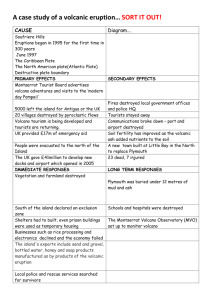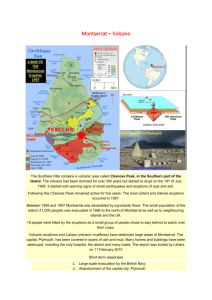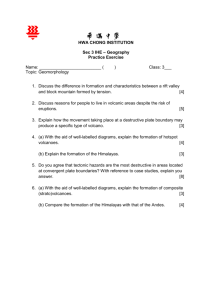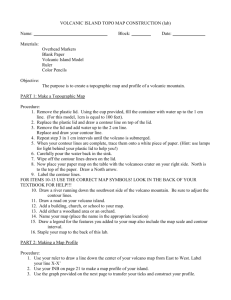March 04 Newsletter - The Open University
advertisement
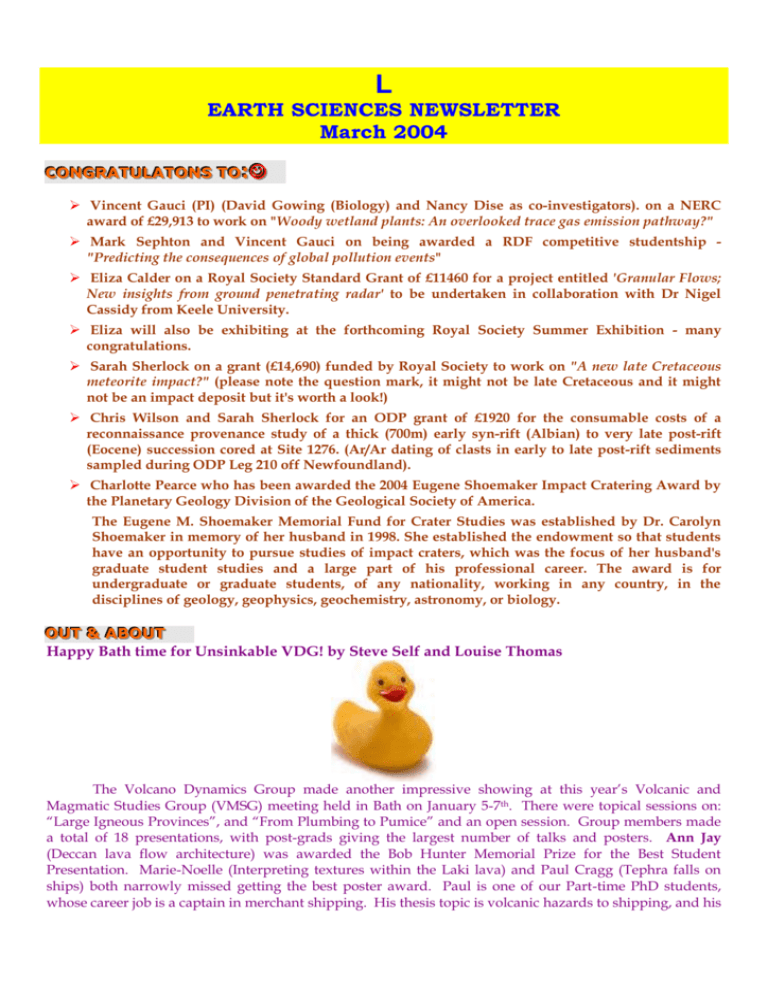
L
EARTH SCIENCES NEWSLETTER
March 2004
C
CO
ON
NG
GR
RA
AT
TU
ULLA
AT
TO
ON
NS
ST
TO
O::
Vincent Gauci (PI) (David Gowing (Biology) and Nancy Dise as co-investigators). on a NERC
award of £29,913 to work on "Woody wetland plants: An overlooked trace gas emission pathway?"
Mark Sephton and Vincent Gauci on being awarded a RDF competitive studentship "Predicting the consequences of global pollution events"
Eliza Calder on a Royal Society Standard Grant of £11460 for a project entitled 'Granular Flows;
New insights from ground penetrating radar' to be undertaken in collaboration with Dr Nigel
Cassidy from Keele University.
Eliza will also be exhibiting at the forthcoming Royal Society Summer Exhibition - many
congratulations.
Sarah Sherlock on a grant (£14,690) funded by Royal Society to work on "A new late Cretaceous
meteorite impact?" (please note the question mark, it might not be late Cretaceous and it might
not be an impact deposit but it's worth a look!)
Chris Wilson and Sarah Sherlock for an ODP grant of £1920 for the consumable costs of a
reconnaissance provenance study of a thick (700m) early syn-rift (Albian) to very late post-rift
(Eocene) succession cored at Site 1276. (Ar/Ar dating of clasts in early to late post-rift sediments
sampled during ODP Leg 210 off Newfoundland).
Charlotte Pearce who has been awarded the 2004 Eugene Shoemaker Impact Cratering Award by
the Planetary Geology Division of the Geological Society of America.
The Eugene M. Shoemaker Memorial Fund for Crater Studies was established by Dr. Carolyn
Shoemaker in memory of her husband in 1998. She established the endowment so that students
have an opportunity to pursue studies of impact craters, which was the focus of her husband's
graduate student studies and a large part of his professional career. The award is for
undergraduate or graduate students, of any nationality, working in any country, in the
disciplines of geology, geophysics, geochemistry, astronomy, or biology.
O
OU
UT
T&
&A
AB
BO
OU
UT
T
Happy Bath time for Unsinkable VDG! by Steve Self and Louise Thomas
The Volcano Dynamics Group made another impressive showing at this year’s Volcanic and
Magmatic Studies Group (VMSG) meeting held in Bath on January 5-7th. There were topical sessions on:
“Large Igneous Provinces”, and “From Plumbing to Pumice” and an open session. Group members made
a total of 18 presentations, with post-grads giving the largest number of talks and posters. Ann Jay
(Deccan lava flow architecture) was awarded the Bob Hunter Memorial Prize for the Best Student
Presentation. Marie-Noelle (Interpreting textures within the Laki lava) and Paul Cragg (Tephra falls on
ships) both narrowly missed getting the best poster award. Paul is one of our Part-time PhD students,
whose career job is a captain in merchant shipping. His thesis topic is volcanic hazards to shipping, and his
poster showed an examination of whether loading by ash fall could cause a typical ocean-going cargo ship
to become unstable and sink (It turns out to be very unlikely!).
This year the VMSG meeting was held, as an experiment, in conjunction with the Min Soc’s Winter
Meeting, which also included one other specialist group as well (Geochemistry). This joint venture was a
mixed success; VMSG members dominated the attendance, the Assembly Rooms in Bath were a lovely, but
logistically and technically poor venue, and it cost a bomb! Next year VMSG will once again plan their
own with just the Geochemistry Group and the meeting will be held here on campus (The Open
University), hosted by our Department.
******************************
A short trip South – Mark Brandon
It seems that every year I have been in at the OU I have headed south, and this year was no
exception. Sarah Hardy and I were on an oceanographic project funded by the Antarctic Funding Initiative
(AFI) off an the Island of South Georgia. We have been funded to investigate the year round oceanographic
conditions at the island, and so designed some fancy kit to sit on the sea floor ('moorings') and make
measurements whilst we are enjoying MK. As it is part of the AFI the projects are designed to be well
focussed and so Sarah and I were heading South for only 3.5 weeks with our British Antarctic Survey
Collaborators to bring the moorings to surface, download the data, and re-deploy the moorings back on the
sea floor.
South Georgia is actually at about the
same latitude as the UK. But unlike our
wonderful climate it doesn’t get a Gulf Stream to
warm it up, and as it surrounded by polar waters
it is almost 60% covered in glaciers. To get there
you also have to cross some pleasant seas…..
We had a couple of days of the weather in the
picture, and the sub text is that we had to work in
front of computer screens whilst coping with it.
Sarah's favourite weather
It always seems to work out, but I am
surprised when the weather calms just as we
have to do our work. Our moorings are weighed
down to the sea floor by train wheels (really!),
and above these, and connected by kevlar is the
float you see in the picture right. This float is
packed with all sorts of science goodies, but to
get it back we have to 'talk' to the float and tell it
to let go of the train wheels. It sounds easy on
paper - but does take time. Through good design
we have got them back every time so far – and
more importantly got all the data.
Pulling the mooring in
Sperm whale diving.
South Georgia was the historic centre of the whaling
industry for the first half of last century. But some reason
these days whale sightings are not so common(!). Whilst we
were working on recovering the moorings two Sperm Whales
circled the ship providing a welcome distraction.
(As an interesting aside they are called Sperm whales
because their head is full of an extremely high quality oil
called Spermaceti. I believe that this oil is such high quality it
is still used in things like rockets and missiles)
I am always worried about showing pictures of
people having fun on field work but I guess I am safe in this
newsletter. After the lack of sleep, hard work, stress and
feeling lousy we finally headed into Grytviken - sort of the
capital of South Georgia – to pick up passengers for the trip
home. This gave us time for one 'jolly' and a trip to see the
Harker Glacier in small boats.
A great afternoon all in all, thankfully without
seasickness. But with freezing winds ('katabatic') rushing off
the glacier, it was not so comfortable.
Sarah Hardy is in this boat in front of
the snout of the Harker Glacier
After our afternoon off, things got pretty fast again and
just as I finished backing up the data we were in
Stanley in the Falkland Islands waiting for a flight
home. This always seems to be a bit of an adventure
and it took 5 flights in all with 24 hours in Santiago de
Chile (at 38˚˚C), a few more in Madrid (10˚˚C) – and then
home just in time for the first really bad weather of the
year (-3˚˚C!).
The joys of a quiet walk in the Falkland Islands
'Oh – you back already then?' said my girlfriend….
So far the moorings have been down on the sea floor for about 15 months and have about another year to
go before we finally recover them.
*************************************************
Two conferences and a couple of field-trips in Mexico by Luke Wooller
I've recently returned from just over 6 weeks spent working in various parts of Mexico. First of all, I
went to Metepec, near Mexico City and in the shadow of Popocatepetl volcano, to participate in the
Penrose conference on Neogene-Quaternary Volcanism. This was made possible by a Penrose grant
covering my registration and accommodation. The meeting included sessions on debris avalanches,
ignimbrites, block and ash flows and Mexican magmatism and volcanology in general. Although
participants were limited in number, I was able to meet and show my work to several people working on
debris avalanches as well as specific Mexican and northern Chilean collapses. The meeting was followed by
a short field excursion to Popo to study the assorted pumice, debris avalanche and debris flow deposits,
and also look at interactions between these and pre-Hispanic settlements.
After the first meeting I was invited to collaborate with Nick Varley of Colima University, who
covered my travel expenses. While there, I attended the Colima Volcanology conference, which was
smaller than the Penrose and mostly in Spanish but was still useful as a hotbed of discussion about all
things Colima-related. I also had the pleasant experience of giving a talk through a microphone on the
same frequency as what I think was a local taxi firm! Once the conference was over, I managed to get a
week on and around Colima Volcano, installing 7 new GPS stations which will allow targeted studies of
fault structures across the volcano. We also found time to complete a topographic survey of a small
parasitic cone. Being quite high altitude, the weather wasn't quite what you expect from Mexico and snow
drifts of up to 8 meters meant getting around the volcano was tricky (and camping was horrendous).
To round off the trip, and the major reason for going, we were joined by five others from Mexico
and the US for a three week integrated geophysical and geochemical investigation of Socorro Island, part of
a small volcanic archipelago which has become stranded from the East Pacific Rise some 500 miles west of
the Mexican mainland. Socorro features a variety of extrusive volcanics with compositions ranging from
basaltic to rhyolitic, and is today dominated by numerous obsidian domes and flows. The idea of fieldwork
on a desert island sounds great in principle: lying on a palm-fringed beach, enjoying the sun and the local
cerveza while the GPS ticks over by your side. Unfortunately, Socorro is nothing like that! The island is
administered by the Mexican Navy, which maintains a small base there. Access is restricted to a limited
number of academic researchers, who pay a small fee in return for transport, accommodation and food.
The base is fairly isolated and poorly supplied, and as such all of these were pretty basic - tripe and beans
for breakfast, and no alcohol at any time to drown your sorrows!
After a 36 hour boat journey on a 1940’s Mexican minesweeper, we reached Socorro and were
shown to our quarters within the base before heading straight up to the volcano. The limited road access
meant that a long hike was needed to reach the field area, and so we decided to spend as much time
camping up there as possible. The summit area of the island is hydrothermally active, and an area of
roughly 600 meters square was chosen for the geophysics and geochemistry (see photo). My part in this
was to collect topographic data using the kinematic GPS. This was harder than it sounded, as the area was
a mixture of mud pools, fumaroles and virtually impenetrable shrubbery / cactus, but over the following
week I managed to get around 20,000 position readings allowing a 2m resolution DEM to be constructed.
This has allowed both a structural assessment from the surface morphology and topographic correction of
the geophysics. While on Socorro, I also set-up a new deformation monitoring network, consisting of 12
GPS stations on a radial path between the summit and the coast and a further 6 around the edge of the
island accessed using a navy speedboat. Taking the boat trips also let us have a look at the incredible
marine life – the area being a breeding ground for humpback whales, as well as giant manta rays, sharks,
dolphins and turtles.
Left: Aerial photo of
the hydrothermal area,
which developed on one of the most recent obsidian domes; Right: Bad photo of the navy base, our home
for three weeks. Breaching humpback calf gives no indication of scale, but looks nice.
Towards the end of the trip, we were able to get a flight on a Navy reconnaissance plane, which was
using the island as a base for anti-smuggling patrols. This being Mexico (“todo, y más, es posible”), the
Navy weren’t content with us taking the usual tourist photo’s through the window, but insisted on
opening the backdoor and letting us lean out to get a better shot! As such, we were able to get a series of
high quality images of both Socorro and nearby Barcena Volcano, as well seeing the field area from a new
and somewhat dizzying perspective. A number of possible structures were visible from the air, which will
hopefully be the subject of later studies.
The full dataset is still being compiled and integrated, but when finished will include (in addition to
the topographic and deformation studies I completed) TEM, self-potential, geomagnetism, VLF, soil gas
concentration, temperature and flux measurements, as well as geochemistry of groundwater and fumarolic
gases. Initial results suggest that the work has allowed a new insight into the composition, structure and
fluid flow within the summit area. Despite the exhausting fieldwork, character-building diet, lack of
alcohol, cold sea-water showers, rampant vegetation and locust swarms, all of us were sad to finally leave
the island. As such we’re planning to return next year to test for changes within the system over time, and
we are also attempting to mount an expedition to Barcena, which erupted in 1952-3 but has yet to be
seriously studied.
***********************************
Express success - by John Murray
The stunning images now coming in from Mars Express have attracted widespread public and
media interest, though I'm pretty sure this is crumbs from the rich man's (i.e. Colin Pillinger's) table off the
back of Beagle 2's silence. The attention is nonetheless deserved, though, for these pictures confirm that the
High Resolution Stereo Camera (HRSC) is a far better instrument than any past or present planetary
spacecraft camera. The great advantage of the HRSC over all other imaging systems is that it images
everything in triple stereo, as well as 4 colour and 3 phase angle, so that as well as the most beautiful
landscapes for publicity we are also getting detailed topography for everything. As any photogeologist is
aware of the necessity of having stereo air coverage, it's always been a surprise to me that no one has done
this before, instead relying on the occasional picture overlap. If things go well, we hope to eventually cover
about half the planet at between 10 and 20 metres resolution, so NASA’s MOLA laser altimeter instrument,
which provides average ground height for 200 metre footprints, and presently has an average spacing
between data profiles of 4 km in equatorial and temperate latitudes, will be superseded. HRSC also
provides far larger (65 km by more than 2000 km) images, so that one can go directly from the broad
overview to the tiniest details.
We’re still recovering from euphoria, but the first few orbits have already demonstrated the quality
of what is in store. The 2000 km image strips show the sequence of widespread subsurface melting and
associated surface collapse, the start of the giant water channels, coalescing to form outwash flood plains
hundreds of kilometres wide, and then the endless plains of sediment deposition. However, the most
interesting images show traces of water channels, ice and lakes of very recent age. If this is confirmed, then
ice and water appear to have been present at the surface in quantities throughout Mars' history. There are
also some surprises which I cannot say too much about at the moment.
I'm looking forward to some virtual geology on another planet. Measurement of dip and strike of
strata, thicknesses of sedimentary layers and volcanic flow units, fault displacements, water channel
profiles and cross sections, slopes, heights of apparent shorelines, depths and profiles of craters, volumes of
volcanoes and lava flows, are all in the offing.
I spent last week at a private HRSC Co-Investigator's Team Meeting in Berlin. Even there, I was
surprised to find just how widespread is the interest in Colin Pillinger and Beagle 2. Our two Finnish
members were complaining that the humblest of Lapland's peasants all know that Beagle 2 is silent, but
have not heard of
*************************
S
SH
HO
OR
RT
T IIT
TE
EM
MS
S
'Carly, Nancy, David Gowing (Biology) and Owen Mountford (CEH) have a paper accepted in 'Science'.
The paper reports the first clear evidence that there is a significant reduction in plant species
biodiversity due to regional-scale atmospheric nitrogen pollution. Carly's work has recently been
presented to the Joint Nature Conservation Committee (English Nature, Scottish Natural Heritage and
Countryside Council for Wales), the government's wildlife and conservation advisors.'
*************************
FFA
AR
RE
EW
WE
ELLLL T
TO
O::
Dick Carlton, Dave Wright and Jo Rhodes - who are leaving at end of March we wish you all a bright, happy and relaxing future.
D
DA
AT
TE
ES
S FFO
OR
RY
YO
OU
UR
RD
DIIA
AR
RIIE
ES
S::
*************************
Keith Bolton is taking early retirement at the end of March. The Pavilion has been booked for a
presentation to Keith on Wednesday 31st March at lunchtime.
Financial Briefing - 3.00 pm 17 March in the PRG room. - Roy Findlay (Science Deanery) takes a broad
look at University and Faculty finances. Open to anyone in Earth Sciences who is interested in the
broader picture. It will take c. 45 minutes - 1 hour.
*************************
FFO
OR
RT
TH
HC
CO
OM
MIIN
NG
GS
SE
EM
MIIN
NA
AR
RS
S
VDG Seminars
5 March
12 March
19 March
26 March
Dr Martina Halmer (Bristol) “100 years of volcanic sulphur emissions into the atmosphere”
Dr Heidy Mader (Bristol) “Rheology of bubbly magma: results and implications”
Elske van Dalfsen, “Microgravity at Stromboli” (short presentation)
Kirti Sharma, “The 1730-1736 eruption of Lanzarote”
2 April
Marie-Noelle Guilbaud, “Rubbly pahoehoe” (short presentation)
PS, also see http://intranet.open.ac.uk/personalpages/j.l.palma/vdgtalks.htm
2004 Student Seminars
Wednesday 19 May
Wednesday 12 May
- Second Year students
- Third Years
****END****
